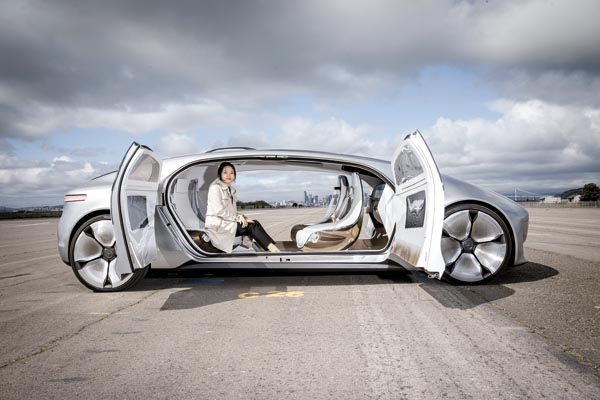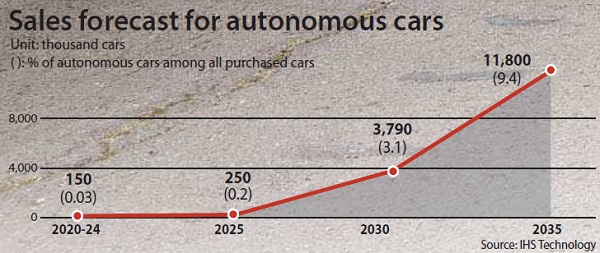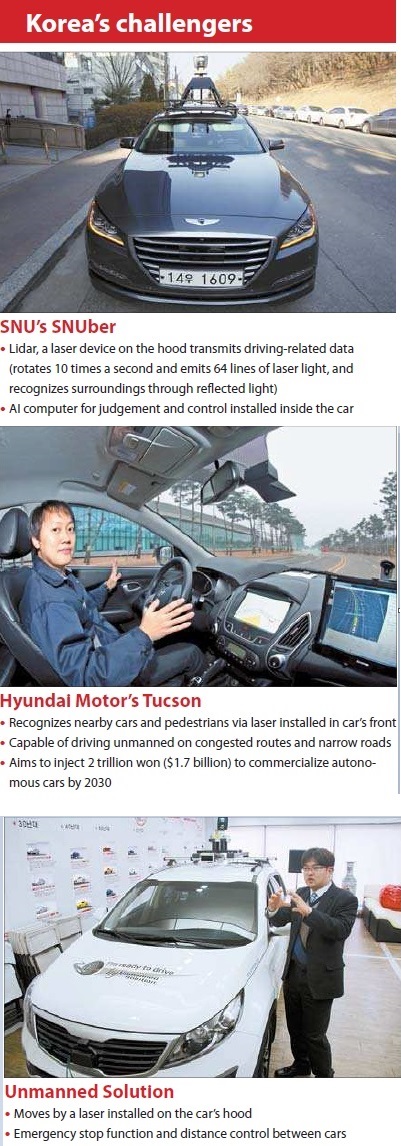Race is on to capture driverless car market

Early last month, a Hyundai Motor Genesis sedan with laser equipment attached to the hood loomed on the beltway around the campus of Seoul National University (SNU) in Gwanak District, southern Seoul.
While the area was covered in a fresh blanket of snow, the car, nicknamed “SNUber” reached speeds of 30 kilometers per hour (19 miles per hour) and successfully dodged busses and cars coming from the opposite direction.
“I think it is the world’s first driverless car to complete a test drive on snow-covered roads where it is hard to distinguish surrounding objects,” said Seo Seung-woo, professor and head of the Intelligent Vehicle IT Research Center at SNU.
The development of SNUber is a major step forward in the Korean intelligent car business. The vehicle can avoid collisions with other vehicles such as Google’s autonomous car. SNUber can also be summoned through a smartphone app.

“Until now, the supremacy of the automobile industry lay in mechanics. However, from now on, AI and big data will replace them,” Seo said.
IHS, a market research firm based in the United States has forecast that complete autonomous car models will start emerging on our streets from 2020 and expand their presence across the world. The company anticipates sales of roughly 11.8 million units by 2035. That means one out of every 10 cars sold will be driverless cars in the future.
Such a high business potential has made the industry a battlefield, with those leading the sector having more experience in IT than in traditional auto manufacturing skills and techniques.
While Google completed the test drive of their vehicle on different roads - adding up to a total 1.8 million kilometers over the last five years - Chinese search engine giant Baidu has joined forces with German automaker BMW.

Still, there are numerous barriers to achieving the goal, and the battle is getting fiercer as the world’s developed nations rush to capture the future growth engine.
Battle of developed nations
The Nissan Advanced Technology Center was built in 2007 in Asugi, near Tokyo, Japan. A total of 1,400 researchers work on technologies for the future. Intelligent cars, including “autonomous vehicles,” are also developed in the center. Yoon Dae-sung, executive director at the Korea Automobile Importers and Distributors Association, visited the center some time ago with Nissan Korea CEO Takehiko Kikuchi. The most notable aspect at the center was that anthropologists were part of the research team.
“They said anthropologists take part in the team to research humans’ behavioral patterns, thoughts and responses to develop a perfect autonomous car. I didn’t know developed countries were putting in such efforts,” Yoon said.
China, which has been notorious for its car imitations, is also showing bold moves in autonomous car development. Baidu, a search engine provider, caught the attention of the public after its autonomous car boasted speed control, U-turn and even outran cars during the recent test drive in Beijing.
Traditional car manufacturers are also focusing their efforts on autonomous car development. “Beijing Automotive Group [BAIC] is planning on another test drive for customers at the Beijing Motor Show to be held in April,” said Cho Ki-soo from the Korea Automobile Manufacturers Association (KAMA). BAIC is currently building a test drive center for autonomous cars outside the motor show venue.
China’s huge land availability offers opportunities for the construction of test centers, backed by the support of regional governments eager to get involved in the growing business.
BAIC is currently negotiating with more than 10 cities in China and at least three cities are expected to allow test drives for driverless cars within this year.

Mercedes-Benz is involved in a project to develop a car that detects hazards even before they are perceived by the driver through Car-to-X communication technology. BMW is developing autonomous cars that can run through Europe’s complicated border points between countries and through tollgates.
To make sure they are not left behind, some automakers are even making alliances with competitors to form a united front. Benz, BMW and Audi jointly acquired Here, a map service provider and a former subsidiary of Nokia, last December, for 3.3 trillion won.
It was a bold challenge to Google Maps. “We will make Here an open platform so more partners can participate,” BMW CEO Harald Krueger said during his visit to Korea on Jan. 11.
However, even for renowned automakers, driverless cars are a tough battle to win. Established automakers such as Nissan, BAIC and Benz fear IT companies are rapidly expanding their presence in the unmanned car sector.
On the progress being made by Google, Apple and Uber, Krueger said, “I think it is serious. No company can ignore such a situation.”
Google has already completed 1.8 million kilometers of test driving over the last five years. “Near the headquarters of Google in Mountain View, tens of autonomous cars run through the road for experiments and data collection. I have concerns on how we can catch up with that gap,” Professor Seo said.
According to Lim Tae-won, head of Hyundai Motor’s Uiwang Choongang Laboratory, its central research center, “Hyundai has leading capabilities to ‘combine’ existing autonomous car technologies but is notably weaker than the United States and Europe when it comes to developing ‘core technology’ such as producing sensors.”
1Korean autonomous cars
On Christmas Eve last year, a Kia Motors Sportage stood filled with parts for autonomous driving at the second floor office of Unmanned Solution, a company specializing in unmanned transportation based in Seocho District, southern Seoul.
The 39-year-old CEO of the company, Moon Hee-chang, referred to it as a test car sold to companies, or laboratories for experimentation.
The unmanned car drives by shooting light through a laser attached to the hood. Emergency brake and distance controls are functions independently developed by the company.
Moon used to be a researcher at Kookmin University, but in 2008, he decided to form a venture company and now, the company can manufacture test cars for autonomous driving. This spring, the company will show off its technologies in an unmanned driving event on a 40-kilometer route that begins from Jeju International Airport.
At Namyang R&D Center in Hwaseong, Gyeonggi, Hyundai Motor Group showed off its driverless car based on the Tucson. The car moved at a speed of 40 kilometers per hour without driver interference. On curved roads, the vehicle automatically slowed to 20 kilometers per hour.
However, the development still has a long way to go. The car operates only on 2.5 kilometers of test road at the R&D center, since only that section of the road has been programmed into the car.
According to the National Highway Traffic Safety Administration’s formal classification, there are five stages of autonomous control, ranging from full driver control to fully automated systems numbered from level 0 to level 4. Korea is currently between levels 2 and 3.
The key focus in the industry is to get to level 4. While various developers have not yet reached that level, plentiful test driving data, financial support and labor backed by government endorsement are bringing the goal within reach.
Many industry insiders say that if Korea aims to take the lead in the business, the government needs to cut regulations regarding test drives. More test run data leads to safer driverless cars, the key to success.
After requests for deregulations, the Ministry of Land, Infrastructure and Transport agreed to permit test drives in a total 320 kilometers of road on five national highways, including Suwon, Hwaseong and Yongin and a 41-kilometer section on the Gyeongbu Expressway from Seoul to Busan.
And there are more requests for government involvement. “For driverless cars to succeed, communication systems between cars and also between cars and road infrastructure must be developed together,” said Kim Beom-jun, a researcher at the LG Economic Research Institute. “We need the government’s help in that part of the development.”
Other important factors include a combination of mechanics and software, along with human resources training.
“Like Germany’s BMW and China’s Baidu [joining forces], Hyundai and Kia should also create a system where university laboratories, venture companies and telecommunication providers all collaborate to maximize synergy,” said Choi Jeong-dan from the Electronics and Telecommunications Research Institute.
Google started its first steps in autonomous car research with talent from Carnegie Mellon University and Stanford University. Nissan is also cooperating with researchers at MIT, Oxford and Tokyo University.
“Even if small enterprises own good technology, it is difficult to manufacture commercial autonomous cars on our own,” said Moon from Unmanned Solution. “Unlike foreign countries, it is difficult to cooperate with conglomerates since there is a big opinion gap between larger companies and small enterprises in Korea.”
BY KIM JOON-SOOL, LIM JI-SOO [kim.jeehee@joongang.co.kr]










with the Korea JoongAng Daily
To write comments, please log in to one of the accounts.
Standards Board Policy (0/250자)